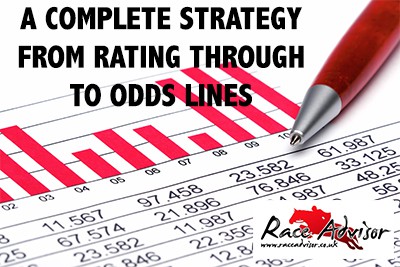A Complete Strategy From Rating Through To Odds Lines

Over the last few weeks I’ve written a post about creating power ratings and a post about turning those ratings into odds lines.
There have been a few requests asking if I could combine them into a single example, and that’s exactly what I’m going to do now.
This post assumes that you have read both the previous posts and I won’t be delving into how, or why, we do the calculations.
It will be a complete guide through the process from beginning to end.
In this example I am going to use my PFP rating from the Racing Dossier. This is a form rating but I recommend using this approach on a combined rating that includes all the factors your want to measure.
The equation that we have created for this rating is:
(0.0177 x Rating Difference) + 0.4998

The first thing we do is make our pairings and mark the difference between the two horses ratings in each pair.


For each of these pairs difference in ratings we perform the equation:
(0.0177 x Rating Difference) + 0.4998
For example the first pair is:

The equation would then be:
(0.0177 x 6) + 0.4998 = 0.606
Doing this for every runner we get:


So far so good. Now we need to combine the results of each of these equations for each runner in the race. To do this we multiply the results for each horse together and raise it to the power of one divided by the number of results. For example Thecornishcowboy has had the results:

There are 5 results and multiplied together they give the figure of 0.1495. Raised to the power of 1/5 it gives the result of 0.68.
For the Excel users amongst you, the formula to multiply this horses ratings together and raise to the power of 1/5 in Excel looks like…
=POWER(PRODUCT(0.606,0.6237,0.6768,0.7299,0.8007),1/5)
Let’s perform the above equation for each of the runners in the race.

There are just two more sums to do before we get our finished odds line.
We need to raise each of these ratings to the power of log(6,2). In Excel this would look like:
=POWER(0.68,LOG(6,2))
This produces the results for each runner of…

If we add all these numbers together they come to 1.93. Ideally we want this to be near 1. The reason for this example not being closer to 1 is because I only used a small sample of data to create the formula, the more data I had used the closer this figure would be to 1.
If you’re figure is very close to 1 then you can use the probabilities as they stand. However as this quite a way off 1 I am going to normalise them by dividing each of the probabilities by 1.93 to give me:

Finally we convert these probabilities into odds by doing the sum of 1/probability for each horse:

Let’s compare these to the SP odds and the finish position of the horses in this race…

As you can see above I’ve highlighted all the horses SP that look to be offering value based on our odds line.
Injun Sands won the race but didn’t look to be offering much value in the odds. However Felix Fabula and Thecornishcowboy both placed with what looked like good value in their odds.
And that’s how you can create an odds line. Don’t forget that you should use as big a sample of data as possible to create your equation and you should be using a rating that encompassess all of a horses factors (as opposed to just form like I did in this example).
Once you’ve got your odds line you then need to determine how you want to bet in the race. If you’d like to see another post about how to do that then please let me know by leaving a comment.
Interesting, but where do the arbitrary numbers in the equation and the log number come from?
They’re explained in the previous two articles which you can read at http://www.raceadvisor.co.uk/power-ratings-a-different-approach/ and http://www.raceadvisor.co.uk/turn-your-power-ratings-into-odds-lines/